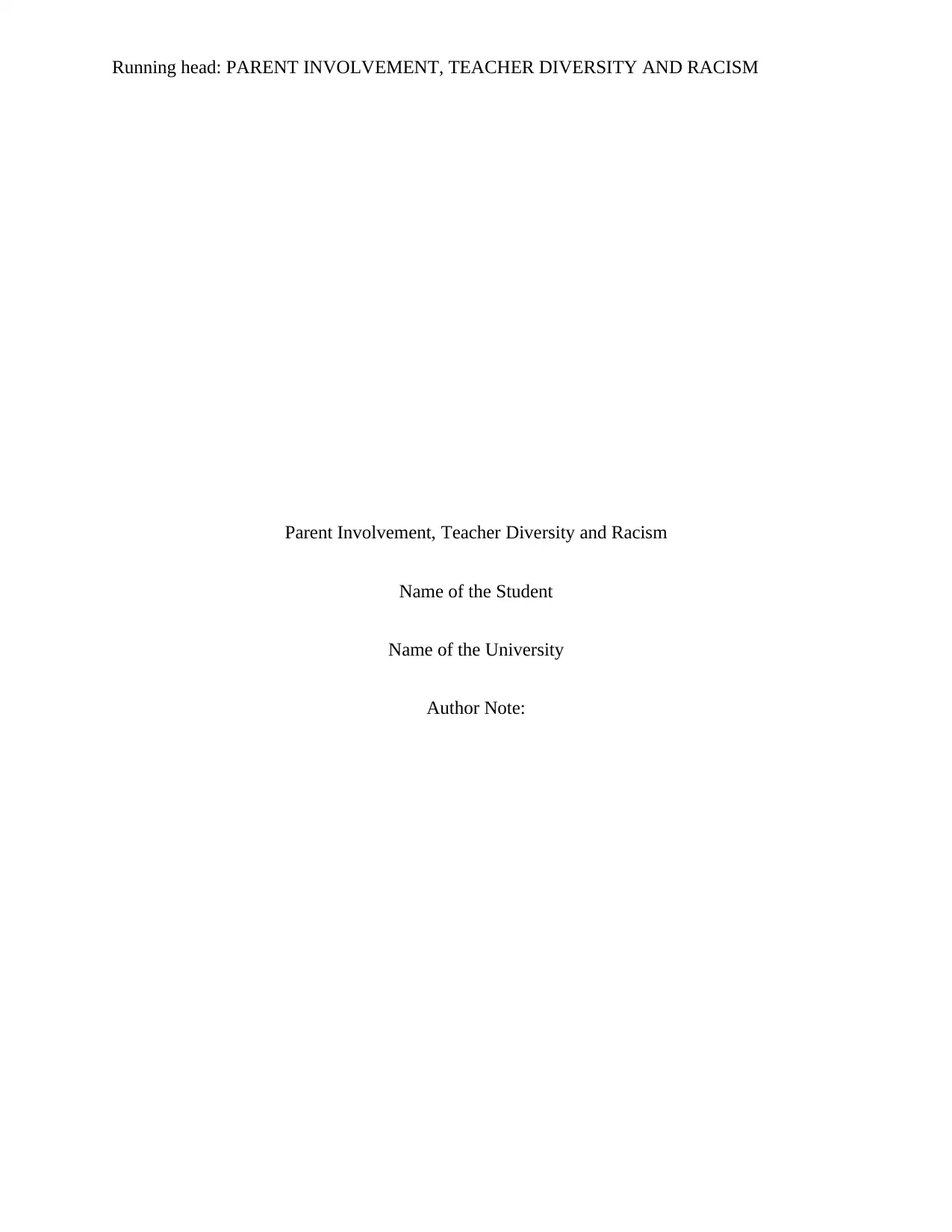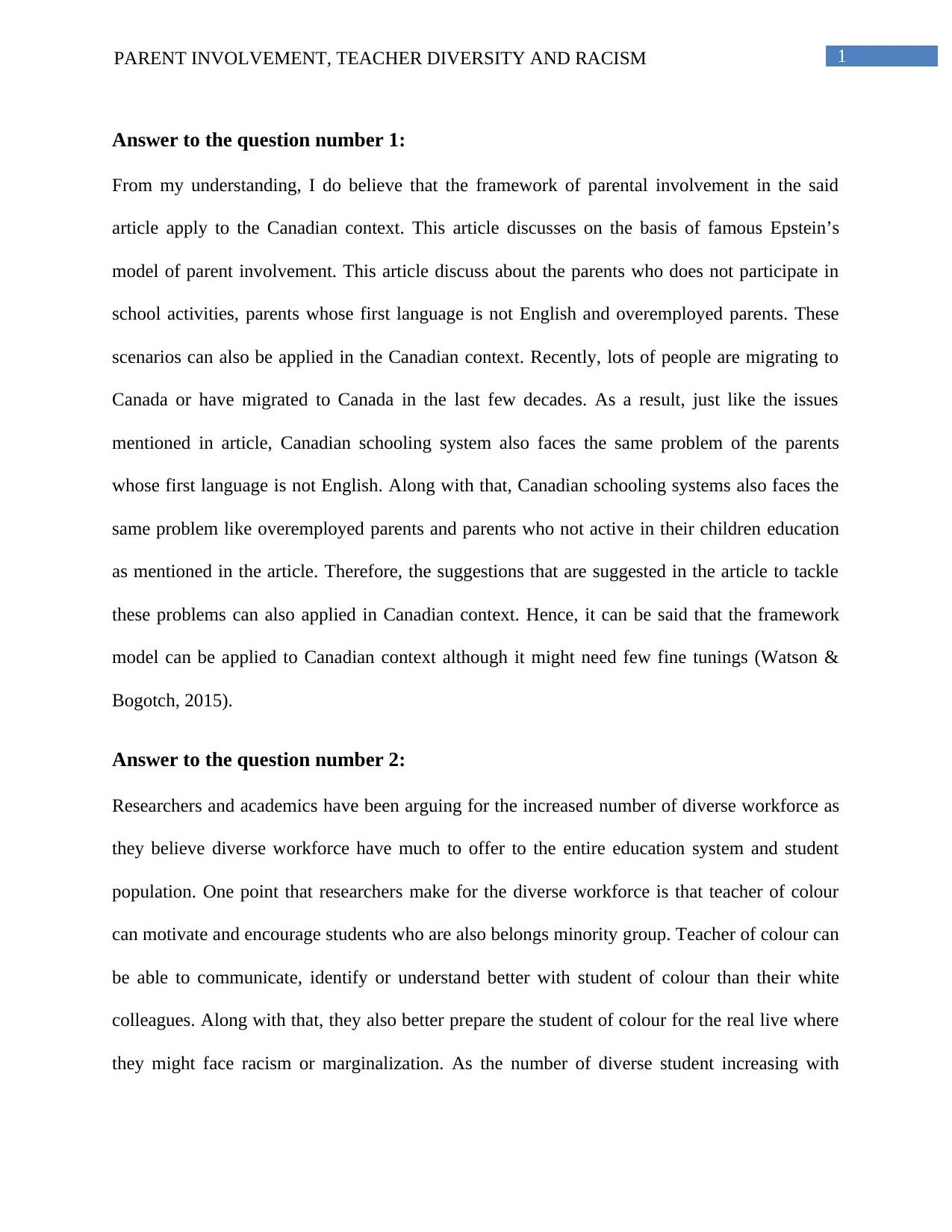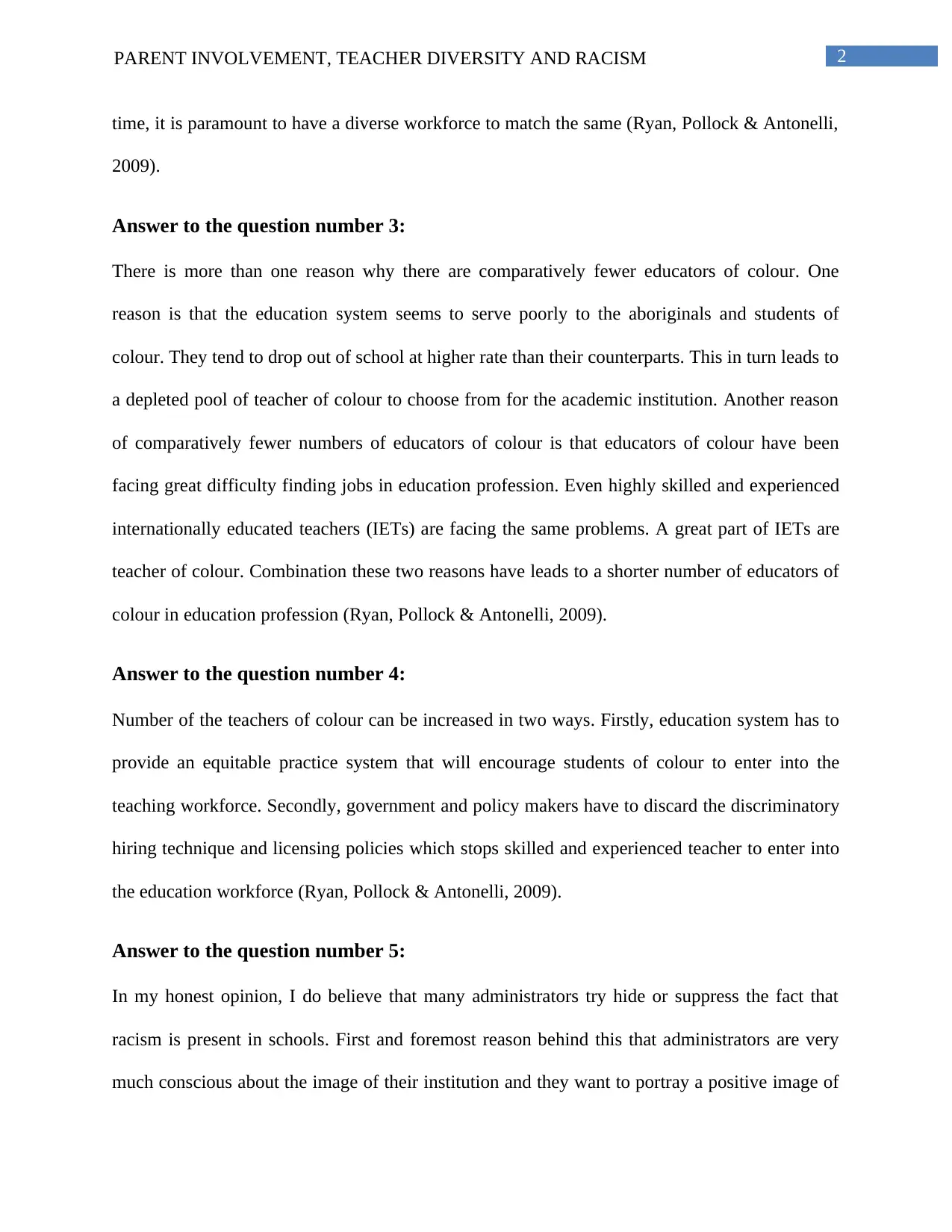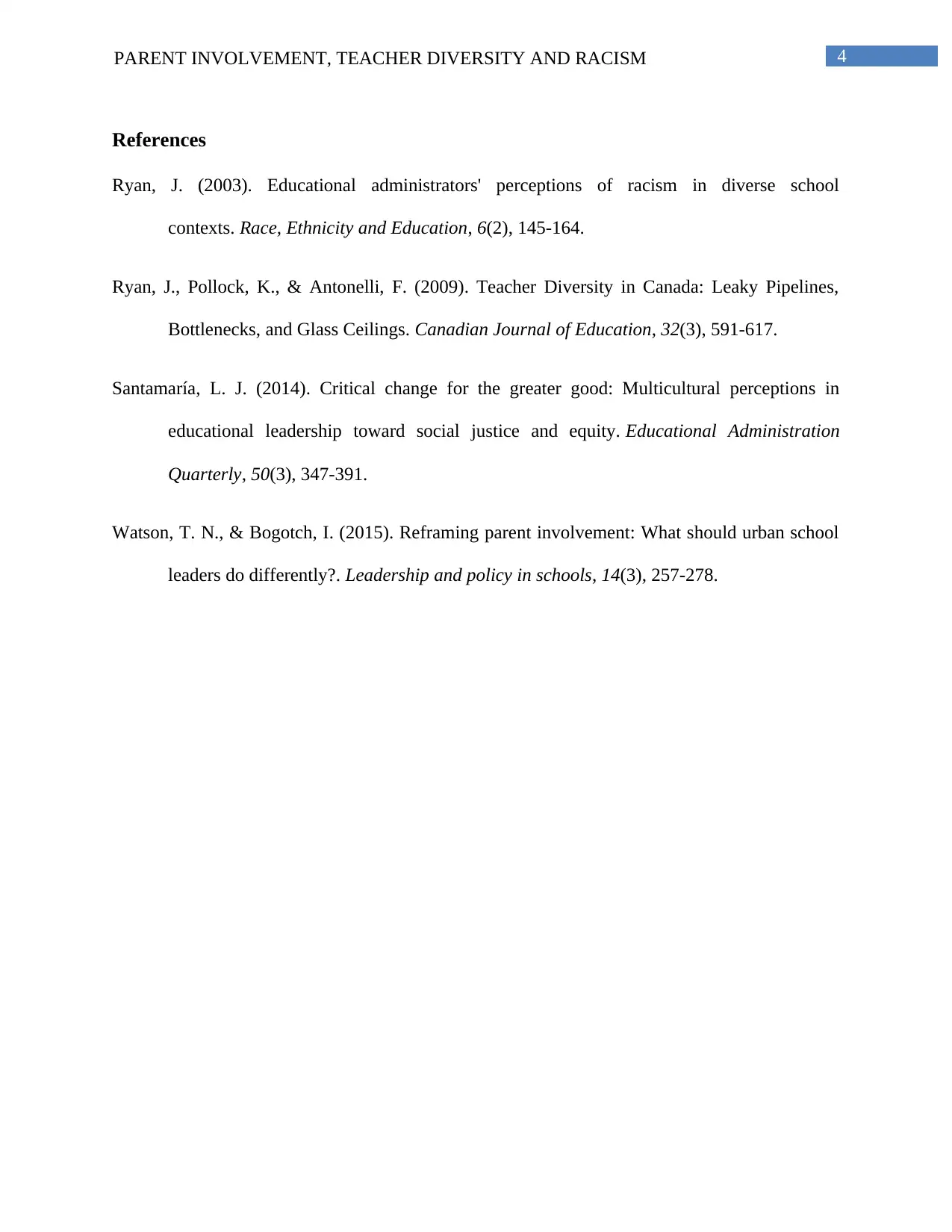Examining Parent Involvement, Teacher Diversity, and Racism in Schools
VerifiedAdded on 2023/06/03
|5
|1089
|267
Essay
AI Summary
This essay examines the framework of parental involvement, particularly in the Canadian context, considering factors like language barriers and overemployment. It highlights the importance of a diverse teaching workforce to motivate minority students and prepare them for real-world challenges, while also addressing the underrepresentation of educators of color due to systemic issues and discriminatory hiring practices. The essay suggests equitable practices and policy changes to increase teacher diversity and argues that administrators sometimes suppress the presence of racism to protect their institution's image. It concludes that administrators with diverse backgrounds can make a significant difference in addressing diversity issues by being more attentive, understanding students' identities, and promoting equity. Access more educational resources and solved assignments on Desklib.

Running head: PARENT INVOLVEMENT, TEACHER DIVERSITY AND RACISM
Parent Involvement, Teacher Diversity and Racism
Name of the Student
Name of the University
Author Note:
Parent Involvement, Teacher Diversity and Racism
Name of the Student
Name of the University
Author Note:
Secure Best Marks with AI Grader
Need help grading? Try our AI Grader for instant feedback on your assignments.

1PARENT INVOLVEMENT, TEACHER DIVERSITY AND RACISM
Answer to the question number 1:
From my understanding, I do believe that the framework of parental involvement in the said
article apply to the Canadian context. This article discusses on the basis of famous Epstein’s
model of parent involvement. This article discuss about the parents who does not participate in
school activities, parents whose first language is not English and overemployed parents. These
scenarios can also be applied in the Canadian context. Recently, lots of people are migrating to
Canada or have migrated to Canada in the last few decades. As a result, just like the issues
mentioned in article, Canadian schooling system also faces the same problem of the parents
whose first language is not English. Along with that, Canadian schooling systems also faces the
same problem like overemployed parents and parents who not active in their children education
as mentioned in the article. Therefore, the suggestions that are suggested in the article to tackle
these problems can also applied in Canadian context. Hence, it can be said that the framework
model can be applied to Canadian context although it might need few fine tunings (Watson &
Bogotch, 2015).
Answer to the question number 2:
Researchers and academics have been arguing for the increased number of diverse workforce as
they believe diverse workforce have much to offer to the entire education system and student
population. One point that researchers make for the diverse workforce is that teacher of colour
can motivate and encourage students who are also belongs minority group. Teacher of colour can
be able to communicate, identify or understand better with student of colour than their white
colleagues. Along with that, they also better prepare the student of colour for the real live where
they might face racism or marginalization. As the number of diverse student increasing with
Answer to the question number 1:
From my understanding, I do believe that the framework of parental involvement in the said
article apply to the Canadian context. This article discusses on the basis of famous Epstein’s
model of parent involvement. This article discuss about the parents who does not participate in
school activities, parents whose first language is not English and overemployed parents. These
scenarios can also be applied in the Canadian context. Recently, lots of people are migrating to
Canada or have migrated to Canada in the last few decades. As a result, just like the issues
mentioned in article, Canadian schooling system also faces the same problem of the parents
whose first language is not English. Along with that, Canadian schooling systems also faces the
same problem like overemployed parents and parents who not active in their children education
as mentioned in the article. Therefore, the suggestions that are suggested in the article to tackle
these problems can also applied in Canadian context. Hence, it can be said that the framework
model can be applied to Canadian context although it might need few fine tunings (Watson &
Bogotch, 2015).
Answer to the question number 2:
Researchers and academics have been arguing for the increased number of diverse workforce as
they believe diverse workforce have much to offer to the entire education system and student
population. One point that researchers make for the diverse workforce is that teacher of colour
can motivate and encourage students who are also belongs minority group. Teacher of colour can
be able to communicate, identify or understand better with student of colour than their white
colleagues. Along with that, they also better prepare the student of colour for the real live where
they might face racism or marginalization. As the number of diverse student increasing with

2PARENT INVOLVEMENT, TEACHER DIVERSITY AND RACISM
time, it is paramount to have a diverse workforce to match the same (Ryan, Pollock & Antonelli,
2009).
Answer to the question number 3:
There is more than one reason why there are comparatively fewer educators of colour. One
reason is that the education system seems to serve poorly to the aboriginals and students of
colour. They tend to drop out of school at higher rate than their counterparts. This in turn leads to
a depleted pool of teacher of colour to choose from for the academic institution. Another reason
of comparatively fewer numbers of educators of colour is that educators of colour have been
facing great difficulty finding jobs in education profession. Even highly skilled and experienced
internationally educated teachers (IETs) are facing the same problems. A great part of IETs are
teacher of colour. Combination these two reasons have leads to a shorter number of educators of
colour in education profession (Ryan, Pollock & Antonelli, 2009).
Answer to the question number 4:
Number of the teachers of colour can be increased in two ways. Firstly, education system has to
provide an equitable practice system that will encourage students of colour to enter into the
teaching workforce. Secondly, government and policy makers have to discard the discriminatory
hiring technique and licensing policies which stops skilled and experienced teacher to enter into
the education workforce (Ryan, Pollock & Antonelli, 2009).
Answer to the question number 5:
In my honest opinion, I do believe that many administrators try hide or suppress the fact that
racism is present in schools. First and foremost reason behind this that administrators are very
much conscious about the image of their institution and they want to portray a positive image of
time, it is paramount to have a diverse workforce to match the same (Ryan, Pollock & Antonelli,
2009).
Answer to the question number 3:
There is more than one reason why there are comparatively fewer educators of colour. One
reason is that the education system seems to serve poorly to the aboriginals and students of
colour. They tend to drop out of school at higher rate than their counterparts. This in turn leads to
a depleted pool of teacher of colour to choose from for the academic institution. Another reason
of comparatively fewer numbers of educators of colour is that educators of colour have been
facing great difficulty finding jobs in education profession. Even highly skilled and experienced
internationally educated teachers (IETs) are facing the same problems. A great part of IETs are
teacher of colour. Combination these two reasons have leads to a shorter number of educators of
colour in education profession (Ryan, Pollock & Antonelli, 2009).
Answer to the question number 4:
Number of the teachers of colour can be increased in two ways. Firstly, education system has to
provide an equitable practice system that will encourage students of colour to enter into the
teaching workforce. Secondly, government and policy makers have to discard the discriminatory
hiring technique and licensing policies which stops skilled and experienced teacher to enter into
the education workforce (Ryan, Pollock & Antonelli, 2009).
Answer to the question number 5:
In my honest opinion, I do believe that many administrators try hide or suppress the fact that
racism is present in schools. First and foremost reason behind this that administrators are very
much conscious about the image of their institution and they want to portray a positive image of

3PARENT INVOLVEMENT, TEACHER DIVERSITY AND RACISM
their institution. They are afraid that admitting the presence of racism might discourage
prospective clients or parents of the student of colour. This is particularly true in the countries
like United Kingdom or Slovenia where administrators are put under pressure to maintain a
positive image of their institution. Another reason might be that administrators or principal does
not believe that the racism present in the school is systemic. They rather seem to believe it is
individualistic and sporadic incident (Ryan, 2003).
Answer to the question number 6:
From my point of view, my understanding is that administrator with racial and ethnic
backgrounds do make a difference in the way they deal with diversity issues. First of all, they
will be much more attentive and compassionate towards an incident and will less likely to be
present and blind eye. Second of all, being an administrator with a racial or ethnic background,
they will have a clear understanding about the student’s racial and ethnic identities. It will help
them to connect with the student better. And last but not the least, administrator with racial or
ethnic background will be much more committed or motivated to achieve equity for all the
students (Santamaría, 2014).
their institution. They are afraid that admitting the presence of racism might discourage
prospective clients or parents of the student of colour. This is particularly true in the countries
like United Kingdom or Slovenia where administrators are put under pressure to maintain a
positive image of their institution. Another reason might be that administrators or principal does
not believe that the racism present in the school is systemic. They rather seem to believe it is
individualistic and sporadic incident (Ryan, 2003).
Answer to the question number 6:
From my point of view, my understanding is that administrator with racial and ethnic
backgrounds do make a difference in the way they deal with diversity issues. First of all, they
will be much more attentive and compassionate towards an incident and will less likely to be
present and blind eye. Second of all, being an administrator with a racial or ethnic background,
they will have a clear understanding about the student’s racial and ethnic identities. It will help
them to connect with the student better. And last but not the least, administrator with racial or
ethnic background will be much more committed or motivated to achieve equity for all the
students (Santamaría, 2014).
Secure Best Marks with AI Grader
Need help grading? Try our AI Grader for instant feedback on your assignments.

4PARENT INVOLVEMENT, TEACHER DIVERSITY AND RACISM
References
Ryan, J. (2003). Educational administrators' perceptions of racism in diverse school
contexts. Race, Ethnicity and Education, 6(2), 145-164.
Ryan, J., Pollock, K., & Antonelli, F. (2009). Teacher Diversity in Canada: Leaky Pipelines,
Bottlenecks, and Glass Ceilings. Canadian Journal of Education, 32(3), 591-617.
Santamaría, L. J. (2014). Critical change for the greater good: Multicultural perceptions in
educational leadership toward social justice and equity. Educational Administration
Quarterly, 50(3), 347-391.
Watson, T. N., & Bogotch, I. (2015). Reframing parent involvement: What should urban school
leaders do differently?. Leadership and policy in schools, 14(3), 257-278.
References
Ryan, J. (2003). Educational administrators' perceptions of racism in diverse school
contexts. Race, Ethnicity and Education, 6(2), 145-164.
Ryan, J., Pollock, K., & Antonelli, F. (2009). Teacher Diversity in Canada: Leaky Pipelines,
Bottlenecks, and Glass Ceilings. Canadian Journal of Education, 32(3), 591-617.
Santamaría, L. J. (2014). Critical change for the greater good: Multicultural perceptions in
educational leadership toward social justice and equity. Educational Administration
Quarterly, 50(3), 347-391.
Watson, T. N., & Bogotch, I. (2015). Reframing parent involvement: What should urban school
leaders do differently?. Leadership and policy in schools, 14(3), 257-278.
1 out of 5
Your All-in-One AI-Powered Toolkit for Academic Success.
+13062052269
info@desklib.com
Available 24*7 on WhatsApp / Email
![[object Object]](/_next/static/media/star-bottom.7253800d.svg)
Unlock your academic potential
© 2024 | Zucol Services PVT LTD | All rights reserved.